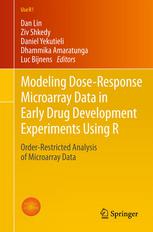

Most ebook files are in PDF format, so you can easily read them using various software such as Foxit Reader or directly on the Google Chrome browser.
Some ebook files are released by publishers in other formats such as .awz, .mobi, .epub, .fb2, etc. You may need to install specific software to read these formats on mobile/PC, such as Calibre.
Please read the tutorial at this link: https://ebookbell.com/faq
We offer FREE conversion to the popular formats you request; however, this may take some time. Therefore, right after payment, please email us, and we will try to provide the service as quickly as possible.
For some exceptional file formats or broken links (if any), please refrain from opening any disputes. Instead, email us first, and we will try to assist within a maximum of 6 hours.
EbookBell Team

4.4
52 reviewsThis book focuses on the analysis of dose-response microarray data in pharmaceutical settings, the goal being to cover this important topic for early drug development experiments and to provide user-friendly R packages that can be used to analyze this data. It is intended for biostatisticians and bioinformaticians in the pharmaceutical industry, biologists, and biostatistics/bioinformatics graduate students.
Part I of the book is an introduction, in which we discuss the dose-response setting and the problem of estimating normal means under order restrictions. In particular, we discuss the pooled-adjacent-violator (PAV) algorithm and isotonic regression, as well as inference under order restrictions and non-linear parametric models, which are used in the second part of the book.
Part II is the core of the book, in which we focus on the analysis of dose-response microarray data. Methodological topics discussed include:
• Multiplicity adjustment
• Test statistics and procedures for the analysis of dose-response microarray data
• Resampling-based inference and use of the SAM method for small-variance genes in the data
• Identification and classification of dose-response curve shapes
• Clustering of order-restricted (but not necessarily monotone) dose-response profiles
• Gene set analysis to facilitate the interpretation of microarray results
• Hierarchical Bayesian models and Bayesian variable selection
• Non-linear models for dose-response microarray data
• Multiple contrast tests
• Multiple confidence intervals for selected parameters adjusted for the false coverage-statement rate
All methodological issues in the book are illustrated using real-world examples of dose-response microarray datasets from early drug development experiments.